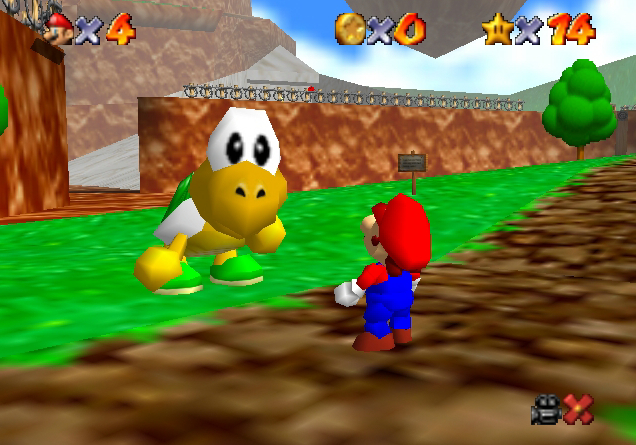Splitting Down The Middle – Mario Mania #5
Good-bye 2-D platforming, hello 3-D polygons and analogue sticks.
Field of Polygon Dreams
A newer, faster, more agile Mario provided many new gameplay possibilities in the third dimension.
Besides being useful, it was also pretty exciting to watch Mario perform acrobatic moves with ease: double- and triple-jumps, backflips, wall kicks, punches, kicks, and forward dives could all be done with essentially the same number of face buttons as found on the SNES controller, but the N64's funky layout somehow made them more accesible (once you got accustomed to the crazy 3-prong monster, of course).
Instead of the strict point-A-to-point-B progression of 2D Mario games, Mario 64's levels were designed like an interactive playground. Canons could launch Mario into other sections of an area, trees and poles could be climbed, an owl could be ridden, several levels had a slide, and most of them had to be conquered like a mountain. Unlike previous Mario games, enemies played a much smaller role in the platforming challenges. There is far less precision required than the 2D Marios, but the sheer amount of long jumps and wall-kicking required keeps the game plenty challenging.
While most people who fell in love with the 2-D Mario titles will be disappointed to learn the power ups and ‘?’ blocks are gone, the power-up caps may help ease that pain. Along the course of your adventure, three hidden courses known as “cap courses” await your discovery. In each course is a “!” switch, which activate the “!” blocks. Red, blue and green blocks are scattered through the fifteen courses. The wing cap grants Mario the ability to fly and is necessary for finding certain power stars; blue caps make Mario turn invisible and allow him to pass through certain walls and barriers; and last is the metal cap, which turns Mario into solid metal and makes him able to walk underwater.
Not every aspect made such a glorious leap to 3D, of course. For one, the camera doesn’t always move to the angle you wish to have, which can either impede or doom your progress. No matter how many times you mash the C-buttons to steer it where you want it to go, if you're standing in a cramped spot, the camera will tend to stick in a certain spot whether it's helpful or not.
The second biggest problem could arguably be repetition. From the barren and boring hub world to having to constantly revisit levels to find every power star, its variety doesn't hold up quite as well as when it first came out.
Mario 64's sound and graphics still have their charm. While a lot of the environments are mostly solid flat surfaces and graphical effects are still 2-D sprites, the use of color make each level, in-game character and effect very nice to look at still. Mario 64 runs quite smoothly, even on the original N64, and graphical tearing doesn’t happen too often. The music, as usual under Koji Kondo’s control, is charming to listen too; themes like Bob-Omb Battlefield and the Bowser levels are still legendary today. Sound effects, such as Mario’s voice and things like explosions and the Goomba’s death cry still put a smile on my face.




Comments